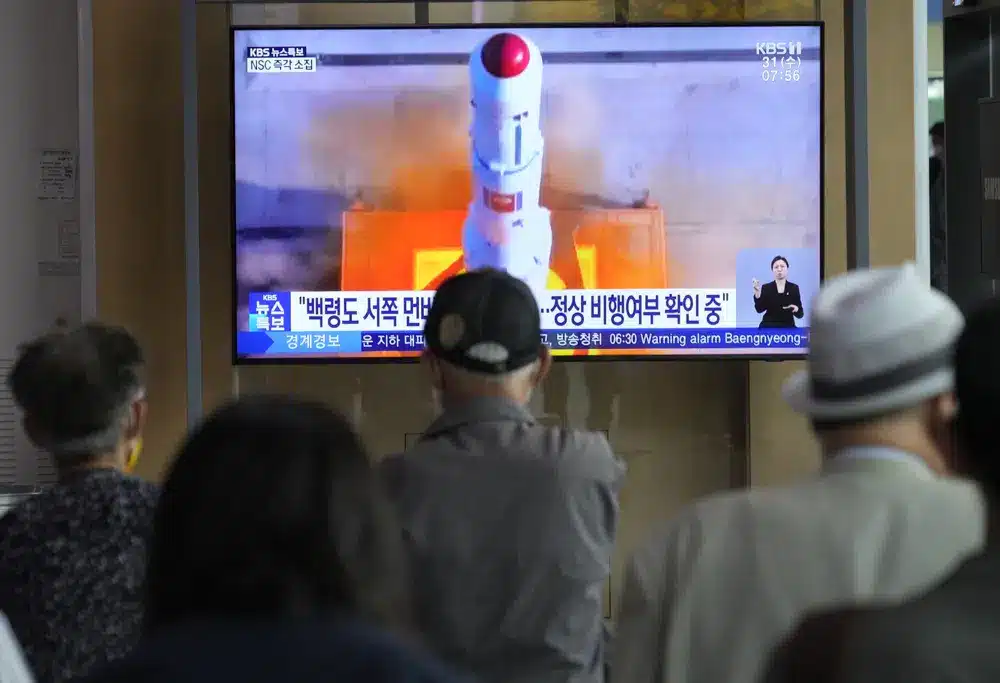NORTH KOREA: SEOUL, South Korea In a blow to leader Kim Jong Un’s efforts to strengthen his military capabilities as tensions with the United States and South Korea escalate, North Korea’s attempt to launch its first spy satellite into space on Wednesday was unsuccessful.
North Korea promised to launch again after learning what went wrong after making an unusually swift acknowledgment of failure. It implies that Kim is still eager to increase his weapons stockpile and put greater pressure on Seoul and Washington while diplomacy is stymied.
After the launch, South Korea and Japan momentarily encouraged inhabitants in some areas to seek refuge.
In waters 200 kilometers (125 miles) west of the southwest island of Eocheongdo, the South Korean military claimed it was retrieving an object thought to be a piece of the fallen North Korean rocket. Later, the Defence Ministry published images of a white metal cylinder that claimed to be a rocket component.
North Korea’s satellite launch violates Security Council resolutions that forbid the nation from carrying out any launch using ballistic technology. According to observers, North Korea’s past satellite launches aided in advancing its long-range missile technology. The capability of North Korean long-range missiles to reach the entire U.S. mainland was proved in previous tests, but foreign experts claim the North still has to make progress in developing operational nuclear weapons.
The Malligyong-1 satellite was launched at 6:37 a.m. by the recently created Chollima-1 rocket from the North’s Sohae Satellite Launching Ground in the northwest. According to the North’s official Korean Central News Agency, the rocket lost thrust after its first and second stages separated, and it crashed off the western coast of the Korean Peninsula.
According to the military of South Korea, the rocket had “an abnormal flight” before it landed in the water. According to Japanese Chief Cabinet Secretary Hirokazu Matsuno, no object is thought to have entered space.
According to North Korean media, the nation’s space agency would look into “the serious defects revealed” by the launch and carry out a follow-up launch as soon as is practical.
North Korea failed to launch its first spy satellite into space on Wednesday.
Leif-Eric Easley, a professor at Ewha University in Seoul, said: “It is impressive when the North Korean regime actually admits failure, but it would be difficult to hide the fact of a satellite launch failure internationally, and the regime will likely offer a different narrative domestically.” This result indicates that Pyongyang may soon organize another provocation to make up for today’s failure.
In a statement, Adam Hodge, a U.S. National Security Council spokesman, said that Washington vehemently opposes the North Korean launch because it used outlawed ballistic missile technology, increased tensions, and put regional and global security at risk.
Because China and Russia, the two permanent members of the Security Council currently engaged in conflicts with the United States, have blocked efforts to put more severe economic sanctions on North Korea, the U.N. has not retaliated to recent tests.
Japan declared it was ready to respond to any emergency, while Seoul’s military claimed it had increased military readiness in collaboration with the United States. The United States declared that it would take all necessary steps to protect its national security and the defense of South Korea and Japan.
The South Korean authorities advised residents of a front-line island off the country’s west coast to leave and find safer places after the launch was discovered. Similar phone messages were sent to city residents by officials in Seoul, the nation’s capital, but the Interior and Safety Ministry later said the Seoul notifications were sent inadvertently. The mayor of Seoul expressed regret for confusing the populace.
Japan turned on its missile warning system for Okinawa Prefecture in the country’s southwest, which is thought to be in the rocket’s probable course. The Japanese advisory stated, “Please evacuate into buildings or underground.”
Yasukazu Hamada, the defense minister of Japan, stated that until June 11, when North Korea’s pre-announced launch window ends, Japan intends to maintain missile defense systems installed in its southern islands and southwestern oceans.
Beyond naming them, KCNA gave no other information on the rocket or the satellite. As with the majority of its previously tested long-range rockets and missiles, experts previously predicted that North Korea would deploy a liquid-fueled rocket.
The National Aerospace Development Administration of the North, according to KCNA, blamed the failure on “the unstable character of the fuel” and “the low reliability and stability of the new-type engine system applied to (the) carrier rocket” despite planning a more thorough examination.
Top North Korean official Ri Pyong Chol stated on Tuesday that the country needs a space-based reconnaissance system to combat growing security threats from South Korea and the U.S.
The spy satellite, earlier revealed in the nation’s state-run media, needed to be sufficiently advanced to produce high-resolution imagery. According to some outside experts, it can spot troop movements and big targets like warships and aircraft.
North Korea failed to launch its first spy satellite into space on Wednesday.
North Korea’s Sohae launch facility was visible in recent commercial satellite photos to be under construction, which suggests the country intends to launch multiple satellites. Ri also stated in his address on Tuesday that North Korea would test “different reconnaissance means” to keep track of the actions of the U.S. and its allies in real-time.
According to Lee Choon Geun, an honorary research fellow at South Korea’s Science and Technology Policy Institute, North Korea might create a space-based surveillance system that enables it to watch the Korean Peninsula in almost real-time with three to five spy satellites.
The satellite is one of many cutting-edge weaponry systems Kim has promised to introduce. He also wants a nuclear submarine, a solid-fuel intercontinental ballistic missile, a hypersonic missile, and a missile with multiple warheads. Kim stressed the strategic importance of a spy satellite during his mid-May visit to the space agency during North Korea’s stalemate with the U.S. and South Korea.
Professor Easley claimed that after competitor South Korea successfully launched its first commercial-grade satellite aboard its home-built Nuri rocket earlier this month, Kim probably pressured his scientists and engineers to launch the spy satellite.
Analysts say Kim likely wants his country to launch its spy satellite before the South to strengthen his military credentials at home. South Korea is anticipated to launch its first spy satellite later this year.
North Korea launched its first satellite into orbit in 2012 and a second in 2016 following a string of failures. Although the government claims both satellites were launched as part of its peaceful space development program, many outside analysts think both were designed to spy on competitors.
According to observers, no proof exists that the satellites have ever returned imagery to North Korea.
SOURCE – (AP)











